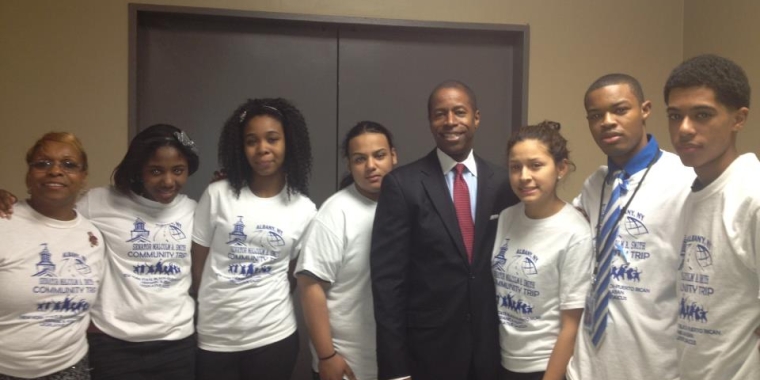
Niagara Falls Underground Railroad Heritage Commission Created
Malcolm A. Smith
June 23, 2008
State lawmakers approve measure to remember last stop before Canadian border
ALBANY, NY – June 23, 2008 – State Senator Antoine Thompson (D-Buffalo/Niagara Falls) and his Senate colleagues have received final passage of a measure creating a 13-member commission to create a cultural corridor in Niagara County honoring the underground railroad, an informal network of secret routes and safe houses used by 19th century Black slaves in the United States to escape to free states and Canada with the aid of abolitionists who were sympathetic to their cause.
The Underground Railroad was at its height between 1810 and 1850. Census figures from that period estimate that 6,000 people escaped enslavement using the Underground Railroad.
“We want to build on our cultural assets,” said Senator Thompson. “We have an internationally-known city with a cultural corridor that we can put into place in such a way that we can create a tremendous economic benefit in the growing industry of cultural tourism. Tourists will be able to visit the old sites, go to shops and boutiques and a tribute plaza.”
The measure was also sponsored by Assemblywoman Francine DelMonte (D-Lewiston).
“Niagara Falls attracts over 8 million visitors every year, but it is so much more than a one-stop tourist destination,” said Assemblywoman DelMonte. “The creation of an Underground Railroad Heritage Area will provide an opportunity for students and families to learn about the role Niagara Falls and Niagara County played during this monumental point in history. In addition, The Underground Railroad Heritage Area will provide a boost to the local economy by encouraging visitors to stay in Niagara Falls longer.”
Approximately two thousand slaves from all slaveholding states were able to escape each year using the Underground Railroad. The psychological impact upon slaveholders of a well-organized network to assist escaped slaves was immense. Under the original Fugitive Slave Law of 1793, the responsibility for catching runaway slaves fell to officials of the states from where the slaves came.
The escape network of the Underground Railroad was not literally subterranean, but rather "underground" in the sense of underground resistance. The network was known as a "railroad" by way of the use of rail terminology in the code. The Underground Railroad consisted of meeting points, secret routes, transportation, and safe houses, and assistance provided by abolitionist sympathizers. Individuals were often organized in small, independent groups, which helped to maintain secrecy since some knew of connecting "stations" along the route but few details of their immediate area.
Due to the risk of discovery, information about routes and safe havens was passed along by word of mouth. Federal marshals and professional bounty hunters known as slave catchers pursued fugitives to Niagara Falls.
The bill allows for twelve members of the commission to be appointed as follows: four to be appointed by the governor, two appointed by the temporary president of the senate, two appointed by the speaker of the assembly, one person appointed by the minority leader of assembly, one appointed by the minority leader of the senate and two members appointed by the mayor of the city of Niagara Falls. The other member will be the chair of the Niagara county legislature, or his or her designee. All appointments need to be residents of the county of Niagara. At the initial meeting the members will elect officers.
“By forming the commission we will be able to provide access to federal and state dollars,” Senator Thompson said. “As many people know, Niagara Falls is the honeymoon capital of the world but it is also the last stop on the Underground Railroad.”
Share this Article or Press Release
Newsroom
Go to NewsroomDemocratic Caucus Weekend in Albany
February 22, 2013

True Icon of New York City, My Friend Ed Koch
February 1, 2013
Sandy Bill Passes; Now It's Time to Go to Work
January 16, 2013